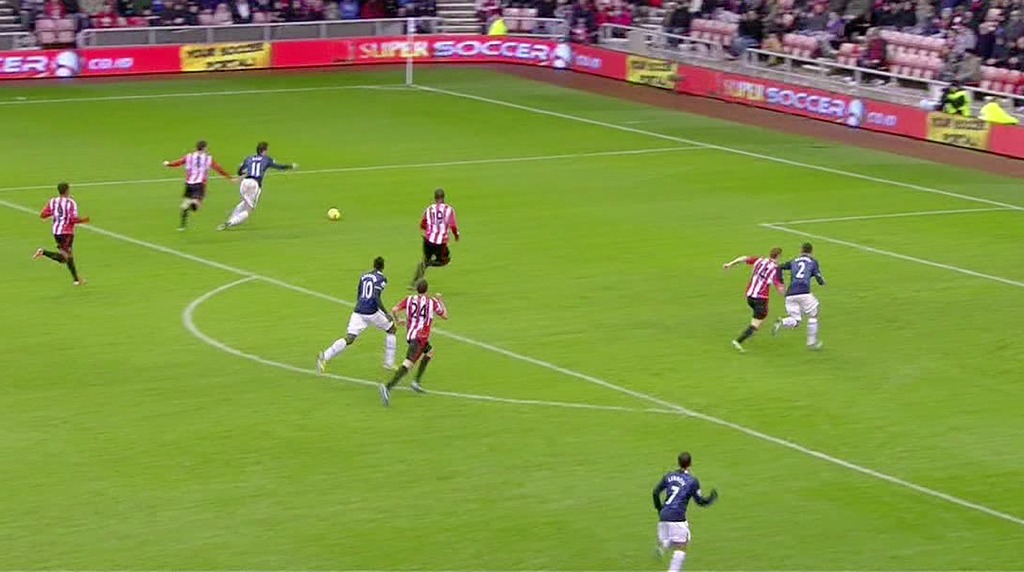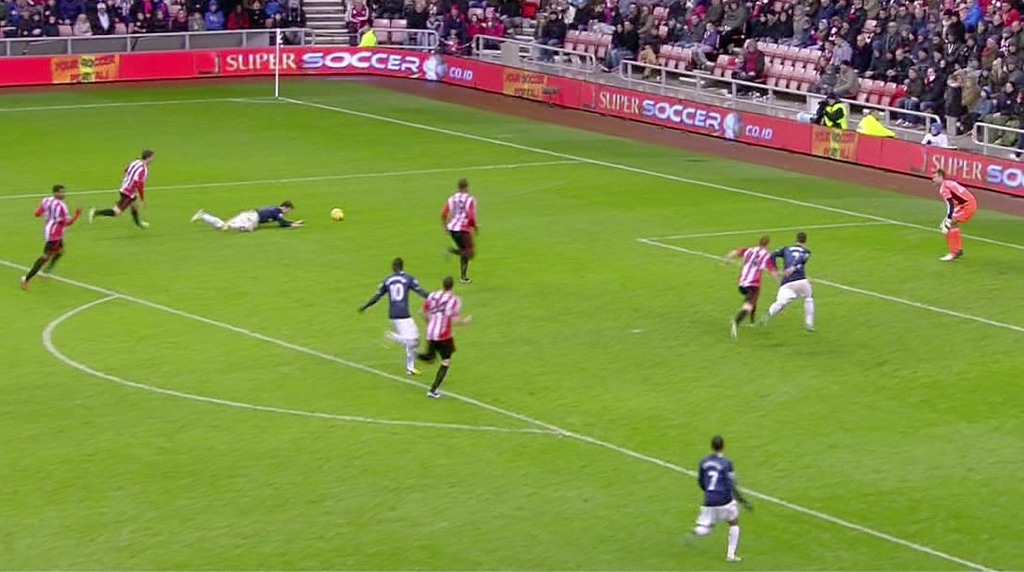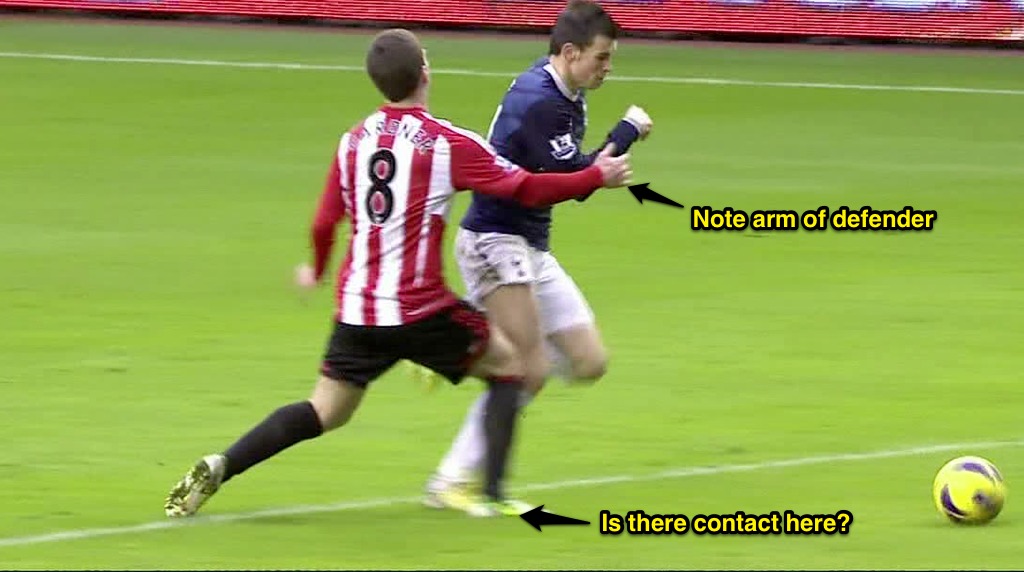| Case Study # | 2-2013 |
| Date | 29 Dec 2012 |
| Competition | Barclays Premier League |
| Fixture/Result | Tottenham Hotspur 2 – 1 Sunderland AFC |
| Referee/Badge | Martin Atkinson, FIFA |
| At Issue | Was Tottenham Hotspur winger Gareth Bale appropriately cautioned for diving? |
In the 80th minute of the match, Spurs winger Gareth Bale beat Sunderland defender Craig Gardner to the outside and penetrated into the penalty area. Gardner, knowing that he was beaten, held Bale with his right arm, clearly making contact. Bale then appears to drag his right foot – which may or may not have made contact with Gardner – and went to ground.
Not only did Referee Atkinson not award a penalty, he cautioned Bale for simulation, which is considered unsporting behavior under the Laws of the Game.
I believe the frames below reveal a couple of important observations:
- Gardner clearly makes contact with Bale with his right arm
- Bale appears to drag his right foot, seeking to draw a foul
Since Gardner makes contact with Bale, the Spurs winger cannot be guilty of simulation. Referee Atkinson may or may not have seen the contact, given that the contact was made on the goal side of the play and the referee was sprinting from behind to catch up.
In this case, Bale’s reputation for simulation (whether deserved or not) may have influenced Atkinson’s decision to issue the caution. It is just as likely, however, that the FA’s guidance to referees to come down harshly on simulation played the bigger role in the referee’s decision.
As a result of receiving his fifth caution of the season, Bale served a one-match suspension.
Learning points:
- Detecting simulation is a very tricky business, especially at the highest levels of the game
- The safer guidance for those of us at the lower levels is to be very certain of a player’s guilt before issuing a caution for simulation
I don’t mean to imply that Atkinson may have been uncertain in his decision. On the contrary, the frames indicate that he quickly reached a decision. My point is this: we’d do well to be 100% certain before taking similar action.











16 responses to “Case Study: Simulating Simulation”
Harris Rasheed liked this on Facebook.
LikeLike
Atkinson was 100% sure, hence the sanction. And at that level, would the contact result in a foul, or was it and should it have been played through?
LikeLike
As watching soccer on TV becomes more widespread, the kids will start to copy the pros. I agree w/you that we need to be very certain when we call simulation.
I was ref in high school game where there were 2 possible cases of simulation. My partner and I ignored them. Neither of us were tempted to call the supposed foul or book the kid for simulation. We discussed it after the game. Should we have booked the kid? Even in hindsight, I can’t say for sure. Yes, there was some minor contact but it also seemed that the kid went down too easy inside the penalty area.
I suspect I’d have to work with a very experienced referee in a game where he booked someone for simulation. This way I could personally see and discuss the events with him. There is no substitution for experience.
LikeLike
RT @itootrdotcom: A new case study, “Simulating Simulation” has been posted. http://t.co/zbq0Lrk3
LikeLike
Fletch, my guess is that a BPL referee doesn’t give that foul, generally speaking. And you’re right about why he saw it as simulation. That fall doesn’t look right, either at speed or in a single frame.
LikeLike
Just proves your point, simulation is tricky to manage. I have booked on occasion, when I was also 100% confident. And it was a repeat offender that I had spoken to earlier in the match but was not effective in stopping the players habit of going down with no or minimal contact.
LikeLike
I am not sure that the contact shown negates a simulation offense. Simulation also includes exaggeration or embellishment in an attempt to deceive the Referee. That appears to be the case here, if the contact is considered trifling…
LikeLike
However isn’t a caution applicable for embellishment? Exaggerating the severity of a foul or injury is also a cautionable offense even if contact occurs.
LikeLike
Robert Reath liked this on Facebook.
LikeLike
Dan, I believe you are correct. I seem to recall seeing guidance that stated that we shouldn’t caution for simulation if contact occurs. After spending a couple of hours trying to find it, I can only find guidance that supports what you are saying. Nice catch, thanks.
LikeLike
The yellow card is issued (and it is mandatory) whenever player “Fakes a foul (dives) or exaggerates the severity of a foul”. The mere fact that contact was made does not mean player can’t “dive” or “exaggerate” the severity of a foul, if one occured. Thus, it is even (at times) possible, although it’s a rare occurence, that a player can be cautioned for this very offence even though he was in fact fouled and awarded a free kick.
LikeLike
Thanks for the clarification.
LikeLike
Mark Streit liked this on Facebook.
LikeLike
Notice how Bale’s head is facing up when he goes down, protecting the head, therefore making the decision that he is going to go down and he protects his head naturally. If the pull truly caused him to fall it would have not been his decision and his head would be facing towards the ground because it would unexpected for him to be pulled to the ground. 100 percent Embellishment. Trifling foul that would not cause him to fall the way he did, so he made the decision to fall and draw a foul that would not be called.
LikeLike
Not 1 of your frames, show the position of the referee when this incident occurred, Before making any comments it may be helpful to see
A the position of the referee
B the incident at full speed, using the what was viewed by the referee
LikeLike
I think we’ve all seen players fouled and then roll over two, three, four times on the pitch. Obviously exaggerating the severity.
LikeLike